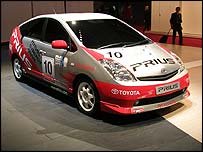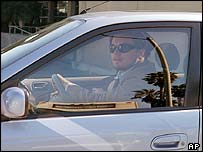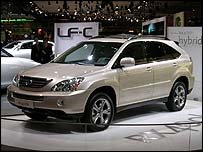Consumer Reports says hybrid cars will lose value faster than other cars. Are they right?
By Peter Valdes-Dapena, CNNMoney staff writer
NEW YORK (CNNMoney.com) - Buying a hybrid will save you money on gas...but you might still come out behind.
One of two main reasons, according to a recent analysis by Consumer Reports, is an additional cost that has typically been treated as an unknown: depreciation. Another factor, the report found, is purchase price -- hybrids simply have higher sticker prices than their non-hybrid counterparts, and gas savings don't do nearly enough to close the gap.
According to Consumer Reports' analysis of six hybrid gasoline/electric vehicles, they will lose 2 percent to 3 percent more in value over five years of ownership than otherwise identical non-hybrid vehicles.
With the purchase price difference, depreciation and other costs like financing and insurance factored in, only the Toyota Prius and Honda Civic Hybrid would save owners any money -- $406 and $317, respectively, over 5 years. That final figure includes the impact of a federal tax incentives for hybrids. Without those incentives, Prius buyers face a net cost of ownership of $2,700 more than Corolla buyers.
Other hhybrid vehicles would cost owners thousands more than non-hybrids over five years of ownership, even after federal tax credits.
For example, a Toyota Highlander Hybrid costs $7,185 more to purchase than the non-hybrid version. That results in $558 more in sales tax and $2,653 more in financing costs. It also will cost $358 more to insure for five years and $12 more in repair and maintenance costs. In addition, the hybrid will also lose 3.9 percent more in value than the non-hybrid.
The Highlander Hybrid will save you about $1,392 in gasoline over that time. So, even with a $2,200 federal tax credit in your bank account, the Highlander Hybrid will ultimately cost you $5,508 more after five years than a similarly-equipped non-hybrid Highlander.
Figures originally published in Consumer Reports magazine on March 1 showed the cost gap being much larger and none of the hybrid vehicles saving owners any money. A correction posted to the magazine's Website Wednesday morning adjusted for a miscalculation in the rate of depreciation. The corrected figures narrow the gap, but all the hybrid vehices still depreciate at a faster rate than non-hybrids, according to the magazine.
Depreciation debate
Depreciation is a major factor in Consumer Reports' analysis. But, experts say, it's difficult to accurately predict depreciation since few mainstream-targeted hybrid vehicles have entered the used car market.
Hybrid supporter and Prius owner James Bell, publisher of the automotive guide IntelliChoice, recently sold his two-year-old Prius for just $4,000 less than he originally paid for it -- a remarkably low rate of depreciation
Even Bell acknowledges, however, his experience isn't a perfect indicator. Unlike most hybrids, the Prius is a uniquely designed vehicle that exists only as a hybrid. There are still waiting lists for new Priuses at dealerships, so some impatient buyers will look for used ones instead.
And even for the Prius, some experts are saying that, because of hybrid cars' technical complexity and additional costs, used car buyers will become wary of them in years to come.
Still, Bell thinks hybrid cars will hold their value at least as well as, if not better than, regular, non-hybrid vehicles. "We don't see any reason at this point to think that a hybrid is going to track along as an outstanding value and then suddenly crash," he said. In spite of increased production, hybrid systems will likely remain rare enough to command a premium among used car buyers, Bell said.
Nonetheless, there may be more effective ways to save on gas than buying a hybrid. Buying a smaller car, for example, or just getting a smaller engine. "Hybrids are kind of a luxury item," points out Jeff Bliskell, who wrote the feature for Consumer Reports.
Some luxury items that provide a tangible benefit, like heated seats, generally add to a vehicle's resale value. Whether a hybrid powertrain provides a real benefit, and will add to the car's value, will depend on a potential buyer's feelings about the social and environmental impact of fuel consumption.
Raj Sunderam, president of Automotive Lease Guide, a company that predicts residual values of cars for the purpose of calculating lease terms, also sees hybrid cars possibly losing value faster than non-hybrids.
"We would agree with Consumer Reports that this is an area of caution," he said.]
But among the unknowns, Sunderam said, is long-term durability. "There's no track record of how they hold up after 80,000 or 100,000 miles," said Sunderam.
As the number of hybrid vehicles available increases, that could also drive used hybrid prices lower. But it could also increase familiarity with the systems and ease potential used car buyers concerns about getting the car serviced, said Sunderam.
Still, said Sunderam, given the issues surrounding hybrid vehicles, the prudent course is to assume they will lose value faster than non-hybrid cars. It will be up to future used car buyers to prove that assumption wrong.
Read More
By Peter Valdes-Dapena, CNNMoney staff writer
NEW YORK (CNNMoney.com) - Buying a hybrid will save you money on gas...but you might still come out behind.
One of two main reasons, according to a recent analysis by Consumer Reports, is an additional cost that has typically been treated as an unknown: depreciation. Another factor, the report found, is purchase price -- hybrids simply have higher sticker prices than their non-hybrid counterparts, and gas savings don't do nearly enough to close the gap.
According to Consumer Reports' analysis of six hybrid gasoline/electric vehicles, they will lose 2 percent to 3 percent more in value over five years of ownership than otherwise identical non-hybrid vehicles.
With the purchase price difference, depreciation and other costs like financing and insurance factored in, only the Toyota Prius and Honda Civic Hybrid would save owners any money -- $406 and $317, respectively, over 5 years. That final figure includes the impact of a federal tax incentives for hybrids. Without those incentives, Prius buyers face a net cost of ownership of $2,700 more than Corolla buyers.
Other hhybrid vehicles would cost owners thousands more than non-hybrids over five years of ownership, even after federal tax credits.
For example, a Toyota Highlander Hybrid costs $7,185 more to purchase than the non-hybrid version. That results in $558 more in sales tax and $2,653 more in financing costs. It also will cost $358 more to insure for five years and $12 more in repair and maintenance costs. In addition, the hybrid will also lose 3.9 percent more in value than the non-hybrid.
The Highlander Hybrid will save you about $1,392 in gasoline over that time. So, even with a $2,200 federal tax credit in your bank account, the Highlander Hybrid will ultimately cost you $5,508 more after five years than a similarly-equipped non-hybrid Highlander.
Figures originally published in Consumer Reports magazine on March 1 showed the cost gap being much larger and none of the hybrid vehicles saving owners any money. A correction posted to the magazine's Website Wednesday morning adjusted for a miscalculation in the rate of depreciation. The corrected figures narrow the gap, but all the hybrid vehices still depreciate at a faster rate than non-hybrids, according to the magazine.
Depreciation debate
Depreciation is a major factor in Consumer Reports' analysis. But, experts say, it's difficult to accurately predict depreciation since few mainstream-targeted hybrid vehicles have entered the used car market.
Hybrid supporter and Prius owner James Bell, publisher of the automotive guide IntelliChoice, recently sold his two-year-old Prius for just $4,000 less than he originally paid for it -- a remarkably low rate of depreciation
Even Bell acknowledges, however, his experience isn't a perfect indicator. Unlike most hybrids, the Prius is a uniquely designed vehicle that exists only as a hybrid. There are still waiting lists for new Priuses at dealerships, so some impatient buyers will look for used ones instead.
And even for the Prius, some experts are saying that, because of hybrid cars' technical complexity and additional costs, used car buyers will become wary of them in years to come.
Still, Bell thinks hybrid cars will hold their value at least as well as, if not better than, regular, non-hybrid vehicles. "We don't see any reason at this point to think that a hybrid is going to track along as an outstanding value and then suddenly crash," he said. In spite of increased production, hybrid systems will likely remain rare enough to command a premium among used car buyers, Bell said.
Nonetheless, there may be more effective ways to save on gas than buying a hybrid. Buying a smaller car, for example, or just getting a smaller engine. "Hybrids are kind of a luxury item," points out Jeff Bliskell, who wrote the feature for Consumer Reports.
Some luxury items that provide a tangible benefit, like heated seats, generally add to a vehicle's resale value. Whether a hybrid powertrain provides a real benefit, and will add to the car's value, will depend on a potential buyer's feelings about the social and environmental impact of fuel consumption.
Raj Sunderam, president of Automotive Lease Guide, a company that predicts residual values of cars for the purpose of calculating lease terms, also sees hybrid cars possibly losing value faster than non-hybrids.
"We would agree with Consumer Reports that this is an area of caution," he said.]
But among the unknowns, Sunderam said, is long-term durability. "There's no track record of how they hold up after 80,000 or 100,000 miles," said Sunderam.
As the number of hybrid vehicles available increases, that could also drive used hybrid prices lower. But it could also increase familiarity with the systems and ease potential used car buyers concerns about getting the car serviced, said Sunderam.
Still, said Sunderam, given the issues surrounding hybrid vehicles, the prudent course is to assume they will lose value faster than non-hybrid cars. It will be up to future used car buyers to prove that assumption wrong.





